A Dialog on Why the Humanities is the Next Frontier

There were always definite no-no’s whenever people have to face the big world of technology and business.
Have a major on English, Philosophy or Theology? Time to worry about what job you’re pursuing after college! Most likely it’s door-to-door Sales, HR, or another job that sucks the life out of you. Pick your poison!
Want to discuss philosophy, religion, and politics with your co-workers? Oh wait. Isn’t that tantamount to social suicide because it’s taboo especially in tech?
I remember the words my father used to say,
“What’s the point? What are you ever gonna get out of the arts and humanities when it comes to your life?”
That was the voice of reason I listened to when I took a business major that catered to app development in college. Not graphic design or anything else (because it wasn’t practical). But then again, a lot of surprises happen.
Surprise 1: I got into user experience, the love of my life, the milk to my latte, the hakuna to my tatas. It was the Aha! moment that brought my previous talents in graphic design and the skills I learned in my major together in one magical hot potato.
Surprise 2: I came to a get-together full of user experience (UX) professionals talking about God, Trump, existentialism and cultural issues. And there I thought I’d only be discussing run-off-the-mill things like wireframes, prototypes, the weather, and maybe even the good Korean Barbecues in the area. Turns out, I was very wrong.
And from those experiences, I figured that the next frontier of UX lies in the strong integration of humanities into the tech industry.
Now, you might be wondering how on earth the humanities can augment the wonderful world of UX and tech. But here’s my take at it: with so many issues happening and with the nature of tech and UX now focusing on collaboration, merging humanities into a field already interdisciplinary really does makes sense especially when you consider the problems the industry currently faces (sexism, racism, and its overwhelming influence).
Why the Tech Industry has Problems
There are a lot of things we can consider rather concerning about the user experience industry, and by extension, the tech industry. Despite my short stint here in sunny California’s professional scene, I’ve heard and experienced my fair share of those concerns.
1. Racism
With its deep festering history heavily rooted in housing and loan opportunities (learn that here from Adam Ruins Everything), it’s no surprise to me that people still have gripes when it comes to interacting with people of different backgrounds.
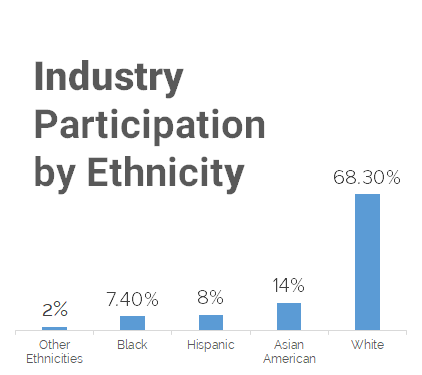
Some of us may think that tech in itself is pretty much an accepting diverse community but if you go look at the regular average standard of participation across all industries, tech has less participation from people who identify as minorities with the exception of Asian Americans.
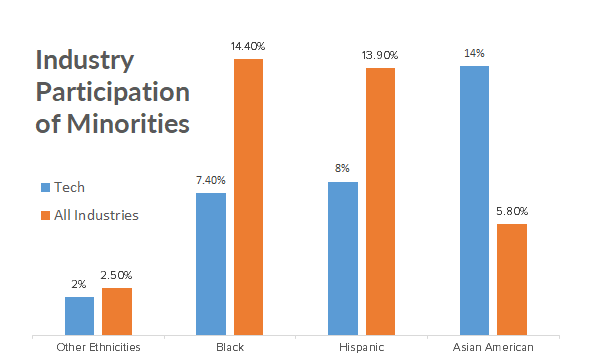
What’s so surprising for me is that it’s the same case in user experience. Go into any UX meetup in Southern California and you can certainly see these sort of numbers.
Sometimes, you even come across ambiguous conversations like this. Here’s one I heard in a big UX conference:
Guy 1: “Hey, bro, we have a token black guy in this activity!”
Guy 2: “Think he’ll end up disrupting the lecture or the speaker? He looks like the type.”
Guy 1: “I don’t know, but I do find that a black guy like him that wants to be a UX professional very weird”
What’s so weird about that?
2. Sexism
Here’s a sexist meme that struck a negative chord with me:
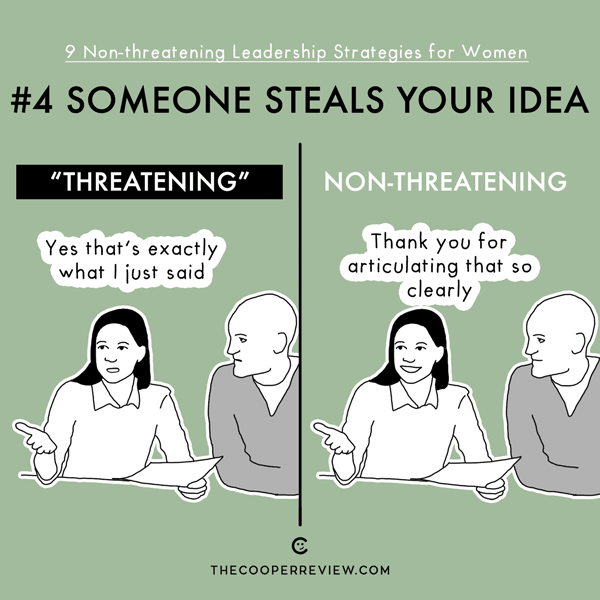
Sadly enough a meme (read: art) can imitate real life. And true enough women happen to have the short end of the stick when you look at statistics.
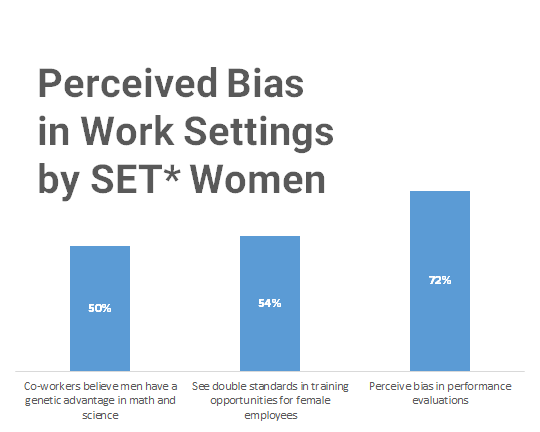
The same thing is clearly observable when you refer to the recent controversies on Google and Uber (Look through Susan Fowler’s negative experience with Uber’s HR here and Jason Damore’s argumentative memo on Google’s management here).
Both cases undermine collaboration and forced both companies into divisive environments (in Google’s case) and uniform ones (in Uber’s case) which can be both bad in different senses.
But the most notable cases of sexism lie in the war stories that we hear from our everyday people. You’ve probably heard of some.
Ever heard of the “You’re not technical enough because you’re feminine” story?
In an interview conducted, a career coach cites the story of her female black colleague who owned a software development company. When dealing with clients, she actually had to say that she was definitely technical and that she knew her stuff when it came to software development because the sexist assumption of her identity came first before the assumption of being experienced by virtue of her job history.
It’s understandable to argue that men and women are different physically but it’s an entirely different thing when you start to generally, and hence erroneously, underestimate a gender/sex’s capability in a work setting.
Why do we have to limit people by what demographic they belong to instead of what they can objectively offer? With a thousand ideas streaming through our head, you’d think we’d manage to balance both emotion and thought into a good business rationale that can be utilized.
3. Overwhelming Power and Influence
We all know that the tech industry is highly influential. By releasing a new phone, letting an app go viral, or even just releasing a new feature, people freak out because tech affects their lives on a daily basis.
But the tech world also knows a lot about us. It knows what we search online, what we’re like, and where we’re even located. Moreover, in different servers out there, bits and pieces of our personal information can be brought together by large companies like Facebook and Google to, as they call it, serve their user base better.
But what exactly can that mean?

Aside from the usual mumbo jumbo that says that tech enhances the quality of life that we live, tech has a large potential for mess-ups. Ever thought of some designer robot taking over the world or living in a matrix built out by some crazy fool? But on a more serious note, can you imagine what happens when some c-suite of a tech conglomerate decides to create services with dark UX (read more about Dark UX Patterns through Rami James’ article), and slowly infect the overarching community with problematic cancer.
Tech as we know it, like human beings, is flawed and dangerous yet absolutely wonderful.
Tech is limitless and transformative. We’re constantly on our toes for better solutions. We find them and eventually make them. What we fail to notice is that what we make often shapes us back mentally, an observable phenomenon that we can see from our information and tech-reliant culture.
The Humanities is Important and Inescapable
With all that laid out in the open, I can’t help but question why the humanities is something we reject on a professional level.
Why do we look at people funny when they say they have a degree in History or Philosophy?
Why do we continuously undervalue the worth of graphic design and underpay freelancers who do it for a living?
One way or another we’ll be dealing with literature, philosophy, politics, linguistics, and all the other fields included in the humanities as we interact with objects and people of different lifestyles. Whether you’re reading a book, listening to music, watching a form of media, or even just plain out standing up for your rights in a courthouse, humanities is seemingly inescapable.
As such, I’d like to ask again: why is it considered taboo to talk about the humanities at all?
In an industry that champions forward-thinking and collaboration (especially in UX), why are we not channeling resources to break past biases and learn from all opinions?
With the problems I mentioned, UX and tech are only selectively collaborative. When conducting hiring and internal processes through a racist or sexist lens, tech-based teams (whether it be in design or development) bind themselves up into echo chambers and they lose the chance to hear valid opinions from different backgrounds, and in a sense, business opportunities.
If it’s a matter of romantic or personal preference, selecting with race and sex can be okay (depending on what sort of relative viewpoint you’re coming from) but when it comes to matters that deal explicitly with the intellect, what reason do we have to discount qualified people from other backgrounds despite the sheer amount of talent out there?
And that’s why a refocusing on humanities can be a good and refreshing elixir to the tech industry’s myopia.
I Make It and It Shapes Me

The Humanities is all about examining what it means to be human in our everyday experiences and doing something about it by shaping the world we live in.
There was a time I had to watch over a toddler for an hour or two as a favor. I had him reading a book in his bag while I tried to absently browse the internet. But then he asked me something I couldn’t directly answer: “What does it mean to be alive?”
Explaining that to a kid can get difficult. Some people find the answer in halls of worship. Others find it on the road or in what they do for a living. It’s always a different experience. And humanities, in its own inescapable way, tackles the variable answer to that question through song, literature, history, politics, philosophy, theology and more. No matter the medium, we constantly express what it means to be human and alive in action and make. We make things in pursuit of our self-set goals and we soon find those things weaving a narrative of who we are through itself.
In the context of tech as a whole, which we have already explained to be highly influential and hence actually does form us back as a social phenomenon, we often find ourselves at a crux.
What do we make? For whom do we make it? Why do we make it?
It’s these sort of questions that the humanities answers that I hope tech and UX can keep asking throughout system development and maintenance. With tech tending to ground itself on earning money with social responsibility added only as a sideshow, maybe the humanities can offer a more critical look and take.
The “I Know Nothing” Mindset
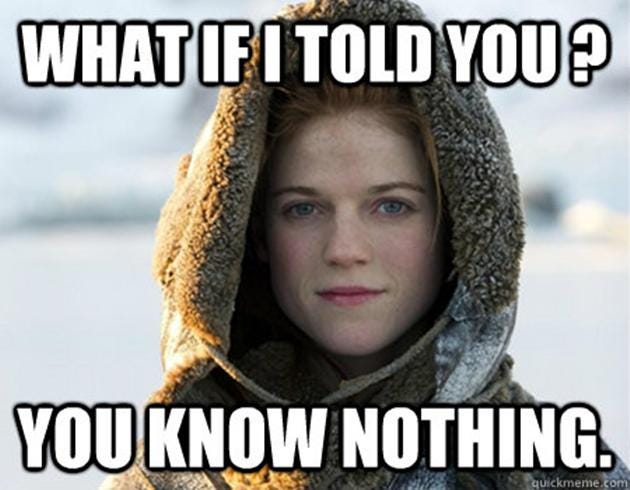
The Humanities actively examines multiples sides to concepts and prides itself in presenting a good understanding of perspective.
Now unless you’re listening in to how your native country is amazing through mandatory state education for children, avid discussions on the topics of humanities are not just limited to one viewpoint. Good teachers and curricula have you go through a whole spectrum of perspectives on one topic and it’ll leave you feeling like the intern that doesn’t know much.
But that’s the best thing about the humanities. Not knowing much. Because when we acknowledge that limitation, we allow ourselves to bask in the reality that there’s an entire world full of discovery out there even if we can’t understand everything about it. In this manner, we open ourselves to keep on learning and actively listening and I’m sure that is better than recklessly pushing a design decision, hiring someone new, or even just sharing insights without any attempts of creating a wholesome understanding.
Putting the Humanities into Action in Tech and UX
Now, imagine if we start injecting that “I know nothing” perspective into the industry whilst acknowledging that whatever we make can make us back.
Imagine how our hiring would be like. Probably a bit more diverse, a little bit more objective by challenging sexism and racism.
Imagine what it’ll be like to make and design applications. Probably will be less reliant on verifying our own assumptions and design decisions which still does definitely happen even on a professional level.
Imagine how it’ll be when we stopped thinking the humanities as taboo. Probably more open to discussing politics (heck maybe even integrate UX into it) among other things.
You might be wondering: “How do we actually do that in a practical sense?”
One answer is to foster that sort of thinking through diversity programs but there’s also so much data and experience out there that just invalidates its viability in a business setting. If you go take a good look at Harvard Business Review’s articles, some diversity programs tend to fail in the sense that its returns are often just temporary or just plain counter-intuitive.
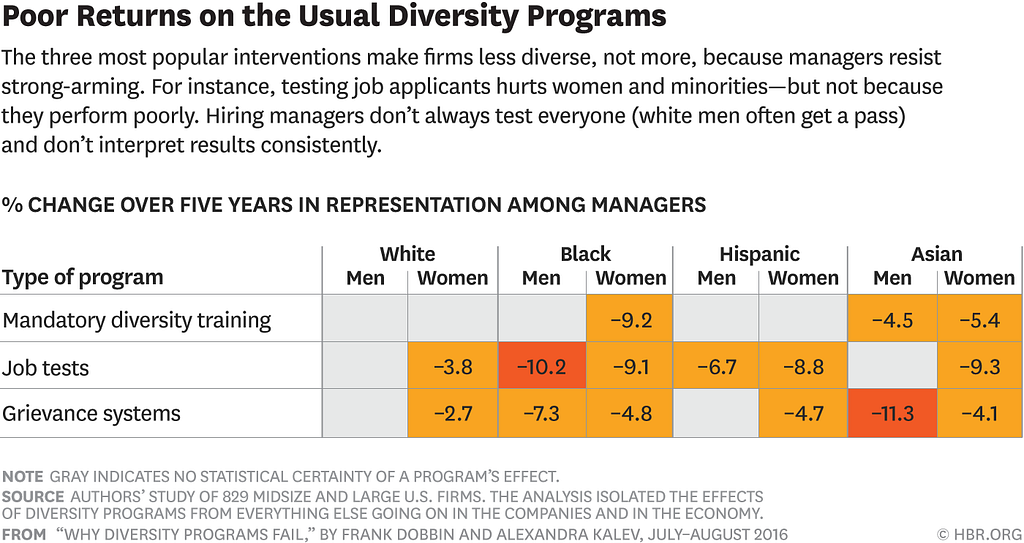
From 2011 to 2016, diversity has lessened for companies that implemented the three most common diversity programs: mandatory diversity training, grievance programs, and job tests (Robert Dobbin’s “Why Diversity Programs Fail). As such Harvard Business Review really does make a good point when they say “we can’t just simply unlearn years of biases.”
From the stories of professionals I’ve heard, there always seems to be a gap from diversity (the numbers) to inclusivity (the behavior) and for them, it’s been a mind-boggling adventure since there isn’t any clear-cut solution to cross that gap as an organization. It’s here that perhaps a good understanding of how the humanities operate can be advantageous and helpful.
When we acknowledge that we know nothing and that we change our world with what we make, we start taking a hard look at how we think and do things.
It’s in this humbleness and openness-to-experience that we can truly be humanely objective. And frankly speaking, UX as a field is at a prime space and mindset to actually practice this.
As an industry that built on collaboration, UX has absorbed methods from marketing, sociology, business, tech, and info design. Moreover, it was built upon the humanities in itself. With its roots in the design of everyday objects and a desire to care for the human condition, user experience is already primed for better integration with the humanitarian. With UX as a young industry, changes can be easily introduced especially from an ideological perspective as there isn’t a common way of doing and teaching things as a whole just yet.
Here are a few ways that we can start:
1. Non-compulsory Exposure
The very base of the whole issue of diversity really just involves pointing out that there’s a problem. We shouldn’t force it and it’s actually very important that we don’t.
As prior research in sociology would explain, “in an effort to enforce their autonomy, people will often disobey rules.” And that rings very true, especially in diversity. One such example demonstrating this is a research effort by the University of Toronto. They had white testers read a brochure about prejudice against the black minority. When people felt pressure to agree with it, the reading strengthened their bias against blacks. When they felt the choice was theirs, the reading reduced bias.
If we want to change what people think of the minority and the taboo, we shouldn’t fight as if people chose to be biased. We should only, at best, share what we think as an equal.
2. Mentoring
Based on a couple of interviews with people who identified as minorities in the design and tech industry, a few excelled in their careers because of various mentors who valued inclusivity. A few of them also opened up that it was their mentors who helped them feel welcome as they try to connect with them on a genuine and personal level. It’s mentors like these that challenge their peers’ biases by presenting minorities they hired in a more objective and supportive light.
Do mentors like these have to be someone in your current company? “No. With the right mindset, you can find a mentor anywhere, anytime, no matter what skill level,” a former Google intern said. The important thing is that you connect, not network. This person is not just a new business card, resume, or contact. They are a human person with aspirations, fears, skills, and opinions just like you, knowable but unknowable as a whole. User experience as a whole already practices empathy in relation to the target personae they design for. What’s stopping companies to practice this internally?
3. Leadership Selection
In the end, it all comes down to selecting good leaders. Whether it’s a CEO, a UX evangelist, or a lead position, influence and change more often than not come from the top if we don’t have the strength of numbers at the grassroots. If we want organizations to be inclusive, we have to be certain that our leaders and influencers also are. According to Robert Dobbin from Harvard Business Review, inclusive leaders have at least three of the following behaviors:
- Ensuring that team members speak up and are heard
- Making it safe to propose novel ideas
- Empowering team members to make decisions
- Taking advice and implementing feedback
- Giving actionable feedback
- Sharing credit for team success
So in regards to what’s actionable, we can either share our concerns with our leaders and hope they follow suit, hire the right leader, or be that leader and influencer for everyone else.
And I invite everyone to follow that calling.
“I’m starting with the man in the mirror.”
— Michael Jackson
Change begins when we acknowledge that we know nothing in comparison to the wealth of perspectives the world has to offer. Change begins when we take a hard look at how we think and do things. Change begins when we acknowledge we have the capacity to do great things.
Change begins by designing the self before designing our make and our world knowing that these things will form us back.
And that, ladies and gentlemen, is what the humanities hopes to instill. Despite all the taboos and negative biases associated with it, humanities has the right tools to help dispel the racial and sexist biases in tech and design. With it, maybe we can finally have the courage to freely and proudly exclaim that tech and UX are collaborative and progressive.
If you enjoyed this article thoroughly, take that finger or cursor of yours and clap clap clap!
The Humanities Belong in Tech and UX was originally published in uxdesign.cc on Medium, where people are continuing the conversation by highlighting and responding to this story.
from uxdesign.cc – Medium https://uxdesign.cc/the-humanities-belong-in-tech-and-ux-dbe93170873f?source=rss—-138adf9c44c—4
